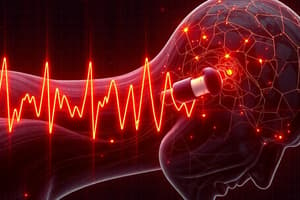Podcast
Questions and Answers
What is the primary purpose of electromyography (EMG)?
What is the primary purpose of electromyography (EMG)?
- To measure skeletal muscle activity (correct)
- To evaluate cardiovascular health
- To monitor respiratory functions
- To assess brain wave patterns
Which neurotransmitter is primarily responsible for initiating muscle contraction as observed in EMG recordings?
Which neurotransmitter is primarily responsible for initiating muscle contraction as observed in EMG recordings?
- Dopamine
- Serotonin
- Norepinephrine
- Acetylcholine (correct)
What type of signals do electrodes detect in electromyography?
What type of signals do electrodes detect in electromyography?
- Changes in membrane potential of muscle fibers (correct)
- Blood pressure fluctuations
- Neural impulses from the brain
- Electrical signals from the heart
In the context of EMG, which of the following applications is NOT commonly associated with the technique?
In the context of EMG, which of the following applications is NOT commonly associated with the technique?
How does a somatic motor neuron influence a motor unit according to EMG principles?
How does a somatic motor neuron influence a motor unit according to EMG principles?
Flashcards
EMG Purpose
EMG Purpose
Measures muscle activity by measuring electrical signals causing muscle contraction.
EMG Applications
EMG Applications
Checks muscle and nerve health and controls devices.
Muscle Action Potential
Muscle Action Potential
Single nerve cell signals a muscle group for contraction.
EMG Signal Recording
EMG Signal Recording
Signup and view all the flashcards
EMG Visualization
EMG Visualization
Signup and view all the flashcards
Study Notes
Electromyography (EMG) Purpose
- Measures muscle activity by quantifying electrical signals causing muscle contraction.
Applications of EMG
- Evaluating muscle and motor neuron health.
- Controlling external devices like LEDs, motors, and robotic tools.
Muscle Action Potential Initiation
- A single motor neuron activates a motor unit by releasing neurotransmitters.
- Neurotransmitters (e.g., acetylcholine) cause electrical changes initiating muscle contraction.
Recording EMG Signals
- Electrodes detect changes in muscle fiber membrane potential.
- EMG outputs electrical signals reflecting muscle activity.
Studying That Suits You
Use AI to generate personalized quizzes and flashcards to suit your learning preferences.
Description
This quiz covers the fundamental aspects of electromyography (EMG), focusing on its purpose, applications, and the initiation of muscle action potentials. Participants will explore how EMG signals are recorded and their relevance in health evaluations and controlling external devices. Test your knowledge on the electrical signals that drive muscle activity!




